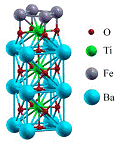Department of Physics and Astronomy: Publications and Other Research
Date of this Version
11-24-2014
Citation
NATURE COMMUNICATIONS 5, 5518 (2014). DOI: 10.1038/ncomms6518
Abstract
Polarization-driven resistive switching in ferroelectric tunnel junctions (FTJs)—structures composed of two electrodes separated by an ultrathin ferroelectric barrier—offers new physics and materials functionalities, as well as exciting opportunities for the next generation of non-volatile memories and logic devices. Performance of FTJs is highly sensitive to the electrical boundary conditions, which can be controlled by electrode material and/or interface engineering. Here, we demonstrate the use of graphene as electrodes in FTJs that allows control of interface properties for significant enhancement of device performance. Ferroelectric polarization stability and resistive switching are strongly affected by a molecular layer at the graphene/BaTiO3 interface. For the FTJ with the interfacial ammonia layer we find an enhanced tunnelling electroresistance (TER) effect of 6 x 105%. The obtained results demonstrate a new approach based on using graphene electrodes for interface-facilitated polarization stability and enhancement of the TER effect, which can be exploited in the FTJbased devices.


Comments
Copyright 2014 NATURE PUBLISHING GROUP. Used by permission.